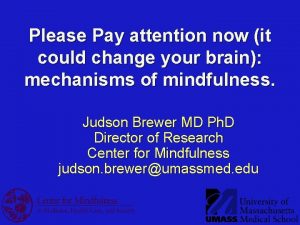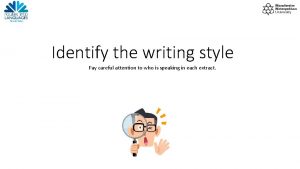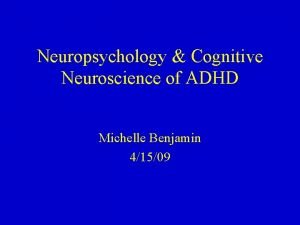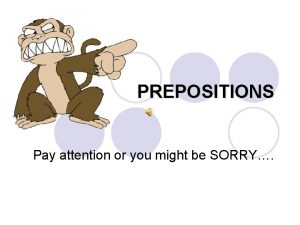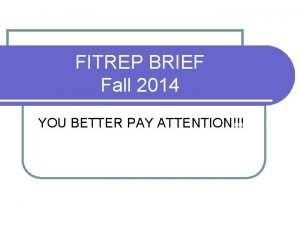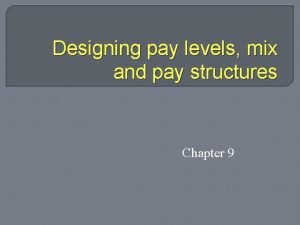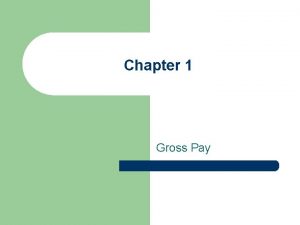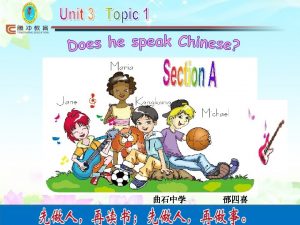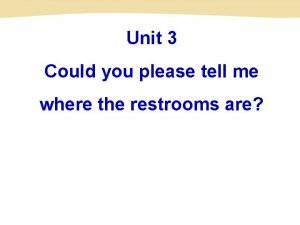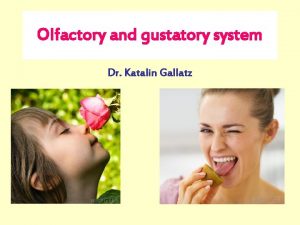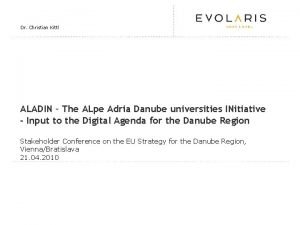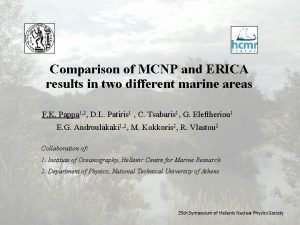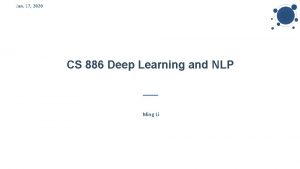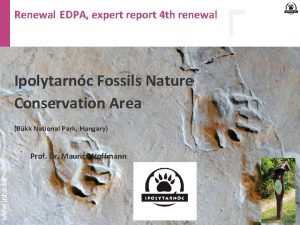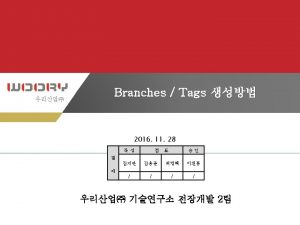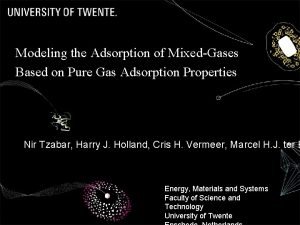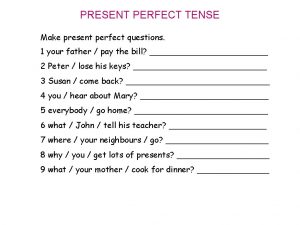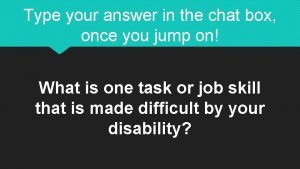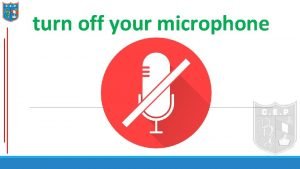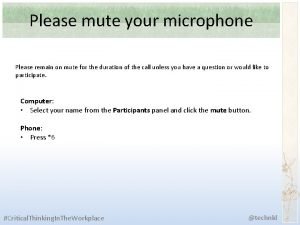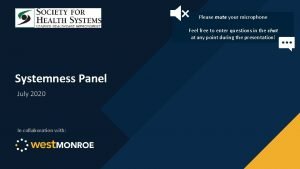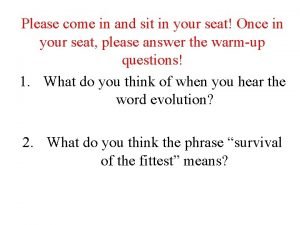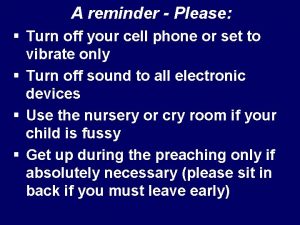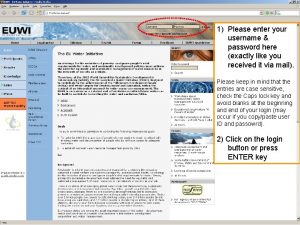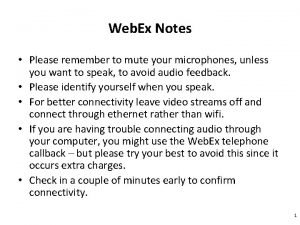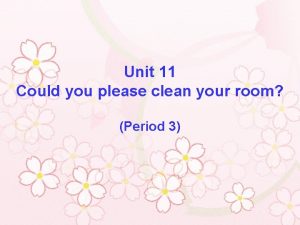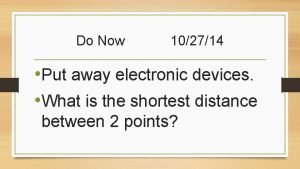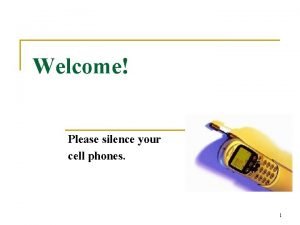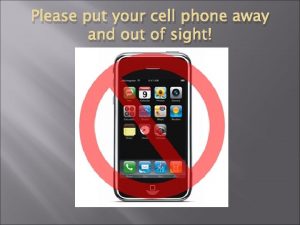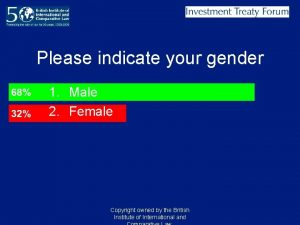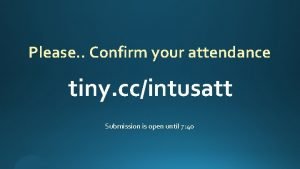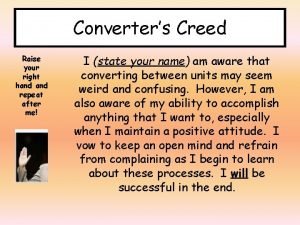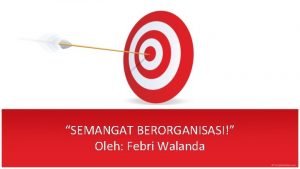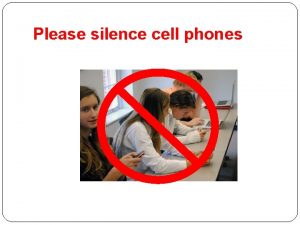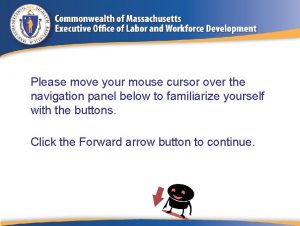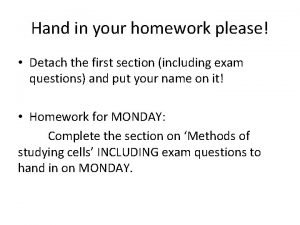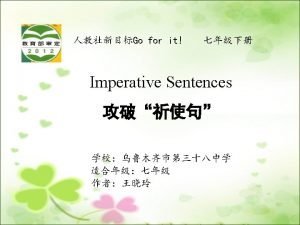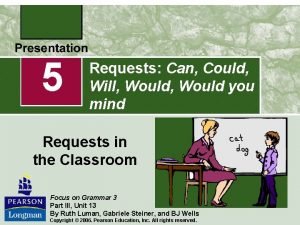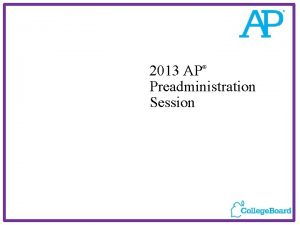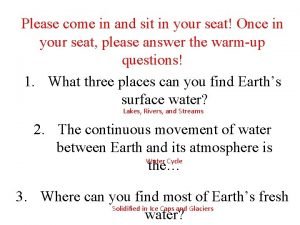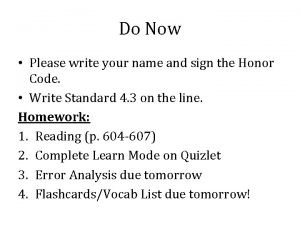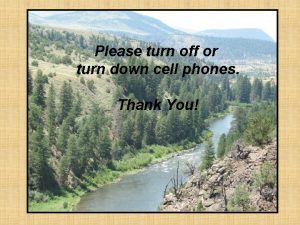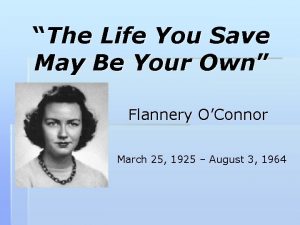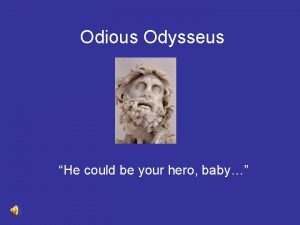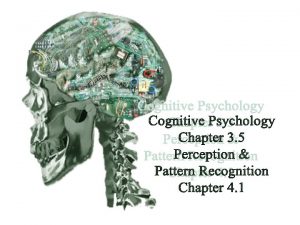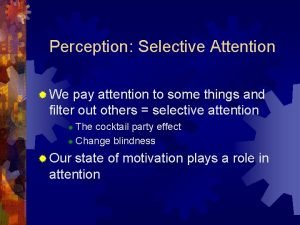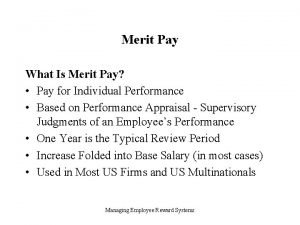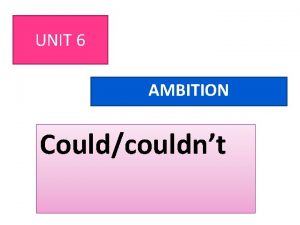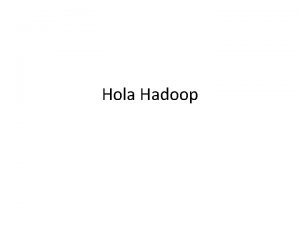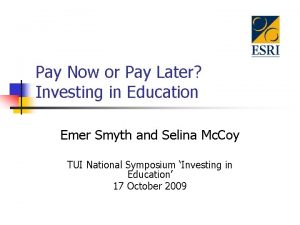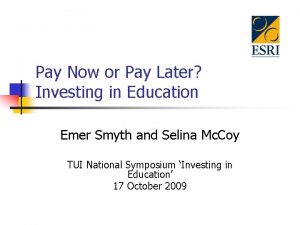Please Pay attention now it could change your



































































































- Slides: 99

Please Pay attention now (it could change your brain): mechanisms of mindfulness. Judson Brewer MD Ph. D Director of Research Center for Mindfulness judson. brewer@umassmed. edu

“Money makes people funny” -Scott Kriens 1440 Foundation

Disclosures • • There is no money in mindfulness training There is no money for research – Write your congressperson! – Formed go. Blue labs (Claritas Mindsciences) • Yale spin-off startup company –Working with social entrepreneurs to translate research into clinical practice


For our consideration • Why Facebook (and love) is like crack cocaine • Why Mc. Donald’s has served over 250 Billion • How Lolo Jones could have won the Olympic gold medal • How we can become a Buddha in nine minutes (and quit smoking too!)

Talking about ourselves is rewarding! Nucleus Accumbens Tamir PNAS (2012) Meshi Front Hum (2013)

Facebook Addiction Disorder (FAD) POSI = Preference for Online Social Interaction Lee et al (2012)

Neural Correlates of Romantic Love Bartels, Andreas; Zeki, Semir Neuro. Report (2000).

Neural Correlates of Romantic Love © 2005 by American Physiological Society Aron A et al. J Neurophysiol (2005)

“Love hurts, love scars, love wounds And mars, any heart Not tough or strong enough To take a lot of pain, take a lot of pain Love is like a cloud Holds a lot of rain Love hurts. . . ooh, ooh love hurts” -Nazareth

“In their quest for happiness, people mistake excitement of the mind for real happiness. ’” -Ven. Sayadaw U. Pandita, In This Very Life

Sensory Information Changes how we see the world

Sensory Information Changes how we see the world

Sensory Information

MIND Cue/Trigger (sight, smell, thought, emotion, body sensation) (evaluation, interpretation) Pleasant Habit formation and reinforcement Unpleasant CRAVING Behavior Birth (of self-identity) Memory (“me”) Brewer, Elwafi and Davis Psych of Addictive Behavior (2012)

Positive Cue Neutral Cue (get in your car) (get yelled at by your boss) r ea s Negative Affect (stressed out) Automated CRAVING SMOKE Maintain or Increase Positive Affect/Decrease Negative Affect i en ce ed S a l Positive Affect (happy or relaxed) In c AVOIDANCE OF CUES Ne gat iv e Rein fo rce men t In c re a s e d S a l i e nc e e in o r f R c e ment iv e Po s i t (have a good meal or sex) Negative Cue SUBSTITUTE BEHAVIORS Reinforcement of Associative Memory/Habit (smoking makes you feel better) Thorndike 1898, Skinner, 1938, Zinser 1992, Piasecki 1997, Carter 1999, Lazev 1999, Cox 2001, Robinson 2003, Bevins 2004, Baker 2004, Cook 2004, Olausson 2004, Shiffman 2004, Carter 2008, Perkins 2010

“Just as a tree, though cut down, can grow again and again if its roots are undamaged and strong, in the same way if the roots of craving are not wholly uprooted sorrows will come again and again. ” -Dhammapada (338)

“I can't get no satisfaction 'Cause I try and I try I can't get no, I can't get no…” -Mick Jaggar


Self-control: competing systems • Affective (self-referential? )/hot processing ! T N A W I – involves self-referential valuation, is automatic and unplanned, and influences behavior through impulses (Weber 2004, Kable 2007). – fronto-striatal-limbic loop, including the orbitofrontal cortex, ventromedial prefrontal cortex (vm. PFC), posterior cingulate cortex (PCC), and ventral striatum (Mc. Clure 2004; Hare 2009; Kober 2010) t o n s ’ t I e m t u o b a • Deliberative/cold processing – effortful, influences behavior through rules of logic and involved in inhibitory control (Weber 2004; Mc. Clure 2004; Ochsner 2005, Knoch 2007; Hare 2009) – dorsolateral prefrontal cortex (dl. PFC), and posterior parietal cortex etc (Mc. Clure 2004; Hare 2009; Kober 2010; Steinbeis 2012)

How to improve the balance between cold and hot processing? HOT COLD


Why study mindfulness? (a Darwinian perspective) CBT Mindfulness Psychoanalysis Ab machine Penicillin t 1/2=?

Overview of Mindfulness Two Component Definition: 1) Self-regulation of attention so that it is maintained on immediate experience, thereby allowing for increased recognition of mental events in the present moment. 2) Adopting a particular orientation toward one’s experiences in the present moment, characterized by curiosity, openness, and acceptance. Bishop 2004

Sensory Information

Mindfulness-based treatments Effective for: – Anxiety (Kabat-Zinn et al 1992, Goldin 2009, others) – Depression (Teasedale et al 2000; Ma et al 2004, Eisendrath 2008, Segal 2010, others) – Pain (e. g. Kabat-Zinn et al 1985, Kingston et al 2007, others) – Addiction (e. g. Brewer 2009, Bowen 2009, Brewer 2011, Carim-Todd 2013) – Boost immune system function (e. g. Davidson 2003, Pace 2009, others) – Boost GRE scores! (Mrazek 2013)

The paradox of Mindfulness: less is more Pay attention, and everything else will take care of itself (really). Brewer Davis and Goldstein Mindfulness (2013)

Greater smoking abstinence with MT vs. Freedom from Smoking Point Prevalence Abstinence (%) 40 35 * MT FFS ** 30 25 20 15 10 *p =. 063 **p =. 012 5 0 End of Treatment 17 week follow-up Brewer et al Drug and Alcohol Dependence (2011)

Working hypothesis • Hypothesis: MT works by decoupling craving and behavior (e. g. smoking) • Prediction: should see dissociation between craving and smoking BEFORE they both subside – i. e. should still have some craving, but it is not coupled to smoking

Craving and cigarette use become dissociated during treatment Craving (QSU) X Cigarette Use Baseline (Week 0) End of Treatment (Week 4) 6 -Week Follow-Up 3 -Month Follow -Up 4 -Month Follow-Up r = 0. 582 p < 0. 001 N = 32 r = 0. 126 p = 0. 491 N=32 r = 0. 474 p = 0. 020 N = 25 r = 0. 788 p < 0. 00001 N=28 r = 0. 768 p < 0. 00001 N=29 p =. 04 Mindfulness practice moderates dissociation Predictor of Smoking r 0. 735 Overall Model Baseline Craving Baseline Cigarette Use End of Treatment Craving Informal practice (days/wk) Craving*Informal (days/wk) R 2 β p Effect size 0. 266 -0. 053 0. 208 -1. 522 0. 515 0. 001 0. 591 0. 53 0. 652 <0. 0001 0. 026 1. 17 0. 540 Elwafi et al Drug and Alcohol Dependence (2013)

Reduction of craving scores with MT Craving Score (QSU) 4. 5 Abstainers 4 3. 5 Non-Abstainers 3 2. 5 2 * 1. 5 1 p = 0. 03 0. 5 0 Baseline End of Trmt 6 -Week f/u 3 -Month f/u 4 -Month f/u Elwafi et al Drug and Alcohol Dependence (2013)

Positive Cue (get in your car) Negative Cue (get yelled at by your boss) r ea s Negative Affect (stressed out) CRAVING SMOKE Maintain or Increase Positive Affect/Decrease Negative Affect i en ce ed S a l Positive Affect (happy or relaxed) In c AVOIDANCE OF CUES Ne gat iv e Rein fo rce men t In c re a s e d S a l i e nc e e in o r f R c e ment iv e Po s i t (have a good meal or sex) Neutral Cue SUBSTITUTE BEHAVIORS Reinforcement of Associative Memory/Habit (smoking makes you feel better) Zinser 1992, Piasecki 1997, Carter 1999, Lazev 1999, Cox 2001, Robinson 2003, Bevins 2004, Baker 2004, Cook 2004, Olausson 2004, Shiffman 2004, Carter 2008, Perkins 2010

“The destruction of craving conquers all suffering. ” -Dhammapada (354)

Craving to Quit (i. Phone App) • 21 day training for smoking cessation • Daily modules – animations • In vivo exercises • Experience Sampling – Test efficacy

Applied mindfulness: RAIN • RECOGNIZE – “Oh that’s a craving” • ACCEPT/ALLOW – See if you are resisting the experience • INVESTIGATE – “what’s happening in my body right now? ” • NOTE – Label or mentally note the body sensations from moment to moment

Mechanisms of Mindfulness? • • • Improved attentional focus (Jha 2007; Lutz 2009) Improved cognitive flexibility (Moore 2009) Reduced affective reactivity (Frewen 2008; Farb 2010; Goldin 2010) • Modification or shifts away from distorted or exaggerated self-view (Teasdale 2002; Ramel 2004; Farb 2007; Goldin 2009) • What’s going on in the brain?



The Underperformance Continuum DAYDREAMING STRESS ADDICTIO N

Default Mode Network (DMN) Andrews-Hanna Neuron (2010)

Overlap between DMN and Self-referential processing Whitfield-Gabrieli Neuroimage (2011)

Resting state anti-coupling between monitoring (d. ACC) and default mode network self/conflic t monitoring default mode network Castellanos et al Biological Psychiatry (2008)

Mindfulness meditation practices Concentration Lovingkindness Choiceless Awareness In the next period, please pay attention to the physical sensation of the breath wherever you feel it most strongly in the body. Follow the natural and spontaneous movement of the breath, not trying to change it in any way. Just pay attention to it. If you find that your attention has wandered to something else, gently but firmly bring it back to the physical sensation of the breath. Please think of a time when you genuinely wished someone well (pause). Using this feeling as a focus, silently wish all beings well, by repeating a few short phrases of your choosing over and over (for example: May all beings be happy, may all beings be healthy, may all beings be safe from harm. ) In the next period please pay attention to whatever comes into your awareness, whether it is a thought, emotion, or body sensation. Just follow it until something else comes into your awareness, not trying to hold onto it or change it in any way. When something else comes into your awareness, just pay attention to it until the next thing comes along. Attention directed at single (physical) object Attention directed at physical and mental objects Attention focused, but not directed to specific object

Task of MT? • The “task” common to all of these meditation techniques is the training of attention away from self-reference and mind-wandering and toward one’s immediate experience. • (Don’t feed the self!)

Experienced meditator study (n=12) Meditation hours Mindfulness Loving Kindness Other Total 7748. 3+4250. 5 1060. 1+958. 9 1756. 8+2476. 6 10565. 2+5148. 9

Trial Time Course baseline 2 min Instructions 30 sec Choiceless Loving Concentration Awareness Kindness Meditation 4. 5 min 2 x Trial (randomized between conditions)

Decreased DMN activity during meditation in experienced meditators (all meditations, Experienced > Novice) x = -6 z = 21 Brewer et al PNAS (2011)

BOLD signal change (%) x = -6 0. 3 0. 1 -0. 3 -0. 5 Meditators Controls -0. 5 z = 21 Meditators Controls

Decreased DMN activity during meditation as compared to both resting and active baselines (n = 20 expert, 26 novice meditators) Meditation > Resting Baseline (eyes open) Meditation > Active Baseline (‘does the word describe you? ’ ‘is the word in upper case? ’) Garrison et al (under review)



“For people who Have agitated thoughts And intense passion, And who are focused on what’s pleasant, Craving grows more and more. Indeed, they strengthen their bonds” -Dhammapada (349)

“Romantic love is one of the most addictive substances on earth. ” -Helen Fisher

Neural substrate of loving kindness meditation Reduced BOLD signal in meditators (n=20) v. novices (n=26) Garrison et al (2014) Brain and Behavior

Hold the door for someone

“Whatever joy there is in this world All comes from desiring others to be happy, And whatever suffering there is in this world All comes from desiring myself to be happy. ” -Shantideva

Does practice make perfect? • Relatively specific deactivation of DMN during meditation – Common to all 3 meditation types – Reproducible • Do state changes during meditation correlate with changes in default brain activation patterns after (a lot of) practice? • Functional connectivity – Seed-based using DMN (Andrews-Hanna 2010) – Helps to control for control state (i. e. what if experienced meditators are meditating during baseline)

Altered DMN connectivity in experienced meditators meditator > control Connectivity z-score 2 1. 5 1 0. 5 Seed region 0 -0. 5 x = 0 -1 Meditators Controls (PCC seed region) Brewer et al PNAS (2011)

meditator > control Baseline (PCC seed region) 2 z = 15 z = 24 Meditation meditator > control Connectivity z-score 1. 5 1 0. 5 0 -0. 5 -1 z = 15 z = 24 Meditators Controls Brewer et al PNAS (2011)

State to trait? Meditators have a different Default Mode!

Relation between Granger causal influences and behavioral performance during visual spatial attention task. Wen X et al. J. Neurosci. 2013 © 2013 by Society for Neuroscience

“Science is a way of trying not to fool yourself. The first principle is that you must not fool yourself, and you are the easiest person to fool. ” -Richard Feynman

Real-time meditation feedback baseline 1 min “active” “dummy” meditate feedback 3 min Garrison et al Neuro. Image (2013)

Real-time Neurofeeback (PCC ROI, n = 22/group) Novice Expert Run 1 Increased self -related activation Decreased selfrelated activation Run 4 Correspondence: 7. 7 ± 0. 29 7. 4 ± 0. 16

Meditate by watching graph (graph of PCC, active feedback) So at the beginning, I caught myself, that I was sort of trying to guess when the words were going to end and when the meditation was going to begin. So I was kind of trying to be like “okay ready, set, go!” and then there was an additional word that popped up and I was like “oh shit” and so that’s the red spike you see there…

Meditate by watching graph (graph of PCC, active feedback) …and then I sort of immediately settled in and I was really getting into it…

Meditate by watching graph (graph of PCC, active feedback) …and then I thought “oh my gosh this is amazing it’s describing exactly what I am saying” and then you see that red spike. . .

Meditate by watching graph (graph of PCC, active feedback) … and I was like “okay, wait don’t get distracted” and then I got back into it and then it got blue again…

Meditate by watching graph (graph of PCC, active feedback) …and I was like “oh my gosh this is unbelievable, it’s doing exactly what my mind is doing” and so [chuckles] then it got red again…

Meditate by watching graph (graph of PCC, active feedback) …So I just find it really funny because it’s…that’s…to the next question, that’s a perfect map of what my mind was going through.

The curious case of the PCC – “Resting state” (Raichle 2001) – Mind-wandering/Disruption of attention (Greicius 2003, Weissman 2006, Mason 2007, Li 2007, Eichele 2008, Wen 2013) – Autobiographical memory, Past and future “self” (Schacter 2007, Andrews-Hanna 2010, others) – Judgment about trait adjectives (Kelley 2002, Whitfield-Gabrieli 2011, others) – Self-attribution in social situations (Cabanis 2013) – Liking a choice you made (Jarcho 2011, Kitayama 2012) – Prevention goals (Strauman 2013) – Induced immoral behavior (van Veen 2009) – Care and justice issues (Caceda 2011) – Guilt (Morey 2012) – Emotional processing (Peyron 2000, Maddock 2002, Zhao 2007, Gentili 2009, Bluhm 2012) – Craving (Garavan 2007, Brody 2002 & 2007, Jarraya 2010)

What about me and the PCC? Andrews-Hanna et al (2014) Ann NYAS

Can we take a deeper dive into the PCC? • Active during a number of cognitive states – Activation seen across multiple populations • Deactivated during mindful states • What exactly does PCC activity correlate with?

Neurophenomenology (Lutz and Thompson 2003) • Use first-person self-report to better understand cognitive processes related to third-person physiological (e. g. , brain imaging) data • Grounded Theory Method (GTM) – Qualitative analysis of self-report data – Derive theory from empirical data

Open Code Open awareness Not “efforting” Central Code Acceptance Calm Tranquility Relaxation Focus on the body Focus on the nostrils Focus on the graph Focus on sensations Focus on visual input Thinking about work Remembering Thinking about a place Thinking about an object Interpreting the task Interpreting the graph Interpreting experience Not “efforting” Pleasure Theoretical Code Equanimity Focus Not “efforting” Clarity Contentment Physical sensations Concentration Mental objects Observing sensory experience Auditory objects Engaging with … Visual objects Interpreting Deliberating Discontentment Remembering “Efforting” Self-related thinking Distraction Displeasure “Efforting” Muddled Discomfort Emotion Surprise Restlessness Confusion Searching Garrison et al (2013) Frontiers in Hum Neuroscience

Activation Distracted Awareness Controlling Distraction Interpreting “Efforting” Discontentment n = 64 n = 56 n = 19 n = 14 Muddled Self-related thinking Deliberating Memories Physical sensations Visual objects Auditory objects Mental objects Displeasure Garrison et al (2013) Frontiers in Hum Neuroscience

PCC Activation “I worried that I wasn’t using the graph as an object of meditation, so I tried, like, to look at it harder or somehow pay attention more to it”

Deactivation Undistracted Awareness Concentration n = 99 Focus on breath Effortless Doing Observing Sensory Experience n = 76 Clarity Physical sensations Visual objects Not “efforting” Contentment n = 48 n = 28 Auditory objects Mental objects Equanimity Pleasure Garrison et al (2013) Frontiers in Hum Neuroscience

PCC Deactivation “Toward the middle I had some thoughts which I don’t see on the graph maybe because I let them kind of flow by” “I noticed …that the more I relaxed and stopped trying to do anything, the bluer it went”

How do studies of the PCC converge? • What about the self is processed in the PCC? (Brewer, Garrison and Whitfield. Gabrieli, 2013) – “getting caught up” in experience? – Mental contraction?

Life is an art, and like perfect art it should be self forgetting; there ought not to be any trace of effort or painful feeling…As soon as there are signs of elaboration, a man is doomed, he is no more a free being. —Suzuki, 1964

Flow a mental state when a person is fully immersed in the present in a feeling of energized focus.

“ There was a sense of flow, being with the breath…flow deepened in the middle. “ -Experienced Meditator

Are you kidding? I have to practice 10, 000 hours to change my default mode?

"Practice does not make perfect. Only perfect practice makes perfect. ” -Vince Lombardi

What ingredients are needed for mindfulness practice? Pay attention

NOVICE MEDITATOR “felt a lot more relaxed, like it was less of a struggle to prevent my mind from wandering” RUN 1 RUN 2 RUN 3 RUN 4

What ingredients are needed for mindfulness practice? Pay attention Relax

EXPERIENCED MEDITATOR “focus on the breath and in particular the feeling of interest, wonder, and joy that arises in conjunction with subtle, mindful breathing”

What ingredients are needed for mindfulness practice? Pay attention Relax Be interested

NOVICE MEDITATOR Thinking about the breath RUN 1 RUN 2 RUN 3 ”focused more on the physical sensation instead of thinking in and out” RUN 4

What ingredients are needed for mindfulness practice? Pay attention Relax Be interested Drop the self

EXPERIENCED MEDITATOR Repeating name Exploring image Future thinking On task Run 1 Run 6

Next steps to move into clinical utility: EEG source-estimated neurofeedback from the PCC

Mindfulness may increase cold while decreasing hot processing ACC PCC dl. PFC HOT COLD

“To study Buddhism is to study the self. To study the self is to forget the self. To forget the self is to be enlightened by all things. To be enlightened by all things is to be free from attachment to the body and mind of one's self and of others. ” —Dogen

Thanks! Subjects Keri Bergquist (Yale) Sarah Bowen (UW) Willoughby Britton (Brown) Kathy Carroll (Yale) Neha Chawla (UW) Todd Constable (Yale) Michael Crowley (Yale) Jake Davis (CUNY) Gaëlle Desbordes (MGH) Cameron Deleone (Yale) Susan Druker Hani Elwafi Kathleen Garrison Jeremy Gray (Yale) Sean (Dae) Houlihan Catherine Kerr (Brown) Hedy Kober (Yale) Cheryl Lacadie (Yale) Sarah Mallik G. Alan Marlatt (UW) Linda Mayes (Yale) Candace Minnix-Cotton Stephanie Noble Alex Ossadtchi (SSI) Prasanta Pal Xenios Papademetris (Yale) Lori Pbert Mark Pflieger (SSI) Marc Potenza (Yale) Maolin Qiu (Yale) Rahil Rojiani Bruce Rounsaville (Yale) Juan Santoyo (Brown) Cliff Saron (UC Davis) Dustin Scheinost (Yale) Rajita Sinha (Yale) Yi-Yuan Tang (Texas Tech) Evan Thompson (Toronto) Tommy Thornhill Nicholas Van Dam (NYU) Katie Witkiewitz (UNM) Jochen Weber (Columbia) Sue Whitfield-Gabrieli (MIT) Patrick Worhunsky (Yale) www. umassmed. edu/cfm FUNDING: NCCAM (R 01 AT 007922 -01), NIDA (R 03 DA 029163 -01 A 1, K 12 DA 00167, P 50 DA 09241), Mind and Life Institute (Varela award), Yale Center for Clinical Investigation (UL 1 RR 024139), Yale Stress Center (UL 1 DE 019586 -02), VAMC MIRECC


BOLD signal change (%) x = -6 0. 3 0. 1 -0. 3 -0. 5 Meditators Controls -0. 5 z = 21 Meditators Controls
 What does the teacher say to get the attention?
What does the teacher say to get the attention? Pay attention to the following instructions carefully
Pay attention to the following instructions carefully Bajo alto gordo perezoso in english
Bajo alto gordo perezoso in english I can't get no satisfaction
I can't get no satisfaction Pay careful attention to your own work
Pay careful attention to your own work Ladies and gentlemen may i have your attention please
Ladies and gentlemen may i have your attention please Trigonal bipyramidal
Trigonal bipyramidal Enagic comp plan
Enagic comp plan Change the direct speech to reported speech
Change the direct speech to reported speech Michelle benjamin phd
Michelle benjamin phd Sorry preposition
Sorry preposition Wake up and pay attention
Wake up and pay attention John roberto
John roberto What is the subject of the announcement
What is the subject of the announcement Pay attention to the following dialogue
Pay attention to the following dialogue Navfit 98
Navfit 98 How much did wanda pay in taxes this pay period?
How much did wanda pay in taxes this pay period? Designing pay structure
Designing pay structure Merit pay vs incentive pay
Merit pay vs incentive pay Lesson 1 hourly vs. salaried
Lesson 1 hourly vs. salaried Will you please be quiet please raymond carver
Will you please be quiet please raymond carver Excuse me . could you tell me
Excuse me . could you tell me Can you please tell me
Can you please tell me Could you tell me where is the bookstore
Could you tell me where is the bookstore Excuse me could you tell me the way to the national museum
Excuse me could you tell me the way to the national museum Now i see it now you don't
Now i see it now you don't Smash mouth somebody once told me
Smash mouth somebody once told me Act now climate change
Act now climate change Welcome to disneyland
Welcome to disneyland Thank you for attention!
Thank you for attention! Retronasal
Retronasal Thank you for your attention
Thank you for your attention Thanks for your attention doctor
Thanks for your attention doctor Thank you for your attention
Thank you for your attention Thank you for your attention
Thank you for your attention Thanks for your attention.
Thanks for your attention. Thank you for your attention
Thank you for your attention Thank you for your attention
Thank you for your attention Thank you for your attention
Thank you for your attention Thank you for your kind attention.
Thank you for your kind attention. Thank you for your attention slide
Thank you for your attention slide Thank u for your attention gif
Thank u for your attention gif Single headed attention rnn: stop thinking with your head
Single headed attention rnn: stop thinking with your head Thank you for your attention
Thank you for your attention Thank you for your attention
Thank you for your attention Thanks for your attention
Thanks for your attention Enrico vicario unifi
Enrico vicario unifi Thank you for your attention
Thank you for your attention Ifnca
Ifnca Thank you for your attention any questions
Thank you for your attention any questions Wp blom
Wp blom Thank you for your attention
Thank you for your attention Thank you for your attention
Thank you for your attention Program kerja kkn bidang kesehatan
Program kerja kkn bidang kesehatan Thanks for your attention
Thanks for your attention Give us your hungry your tired your poor
Give us your hungry your tired your poor Present perfect tense pay
Present perfect tense pay Please type your questions in the chat box
Please type your questions in the chat box Turn on microphone
Turn on microphone Please mute your microphone when not speaking
Please mute your microphone when not speaking Please mute your microphone
Please mute your microphone Sit in your seat
Sit in your seat Please sit down and your seat belts
Please sit down and your seat belts What's a poly relationship
What's a poly relationship Please mute your phone
Please mute your phone Please put your homework my desk
Please put your homework my desk Please turn off your cell phone in church
Please turn off your cell phone in church Please enter your username
Please enter your username Please mute yourself
Please mute yourself If your instructor were to ask if you cleaned up your room
If your instructor were to ask if you cleaned up your room Please clean your own room
Please clean your own room Please your homework this afternoon
Please your homework this afternoon Hand up homework
Hand up homework Please put away your books and come here
Please put away your books and come here Please silence your phone
Please silence your phone Please clean the room before you live
Please clean the room before you live Please put your phone away
Please put your phone away Please indicate your gender
Please indicate your gender Sausage shaped mass
Sausage shaped mass Please turn in your homework
Please turn in your homework Please raise your right hand and repeat after me
Please raise your right hand and repeat after me Please mute your phone
Please mute your phone Please silence your cell phone announcement
Please silence your cell phone announcement Please put here
Please put here Please move your pointer
Please move your pointer Please extend your warm welcome
Please extend your warm welcome Please hand in your homework
Please hand in your homework Be quiet guys
Be quiet guys Please write down your name
Please write down your name What's your favourite foot
What's your favourite foot Could you mind
Could you mind Please write your phone
Please write your phone Please come in and have a seat
Please come in and have a seat Please write your name
Please write your name Please silence your mobile
Please silence your mobile Please turn off your cell phone announcement
Please turn off your cell phone announcement Dramatic irony in the life you save may be your own
Dramatic irony in the life you save may be your own I will sing of your love forever
I will sing of your love forever Let us sing of his love
Let us sing of his love I could be your hero baby
I could be your hero baby



